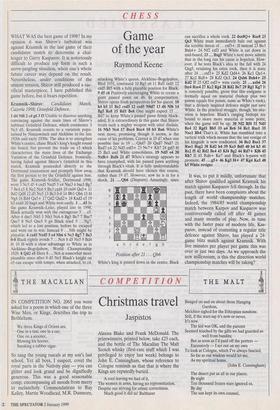Game of the year
Raymond Keene
WHAT WAS the best game of 1998? In my opinion it was Shirov's turbulent win against Kramnik in the last game of their candidates match to determine a chal- lenger to Garry Kasparov. It is notoriously difficult to produce top form in such a nerve-jangling situation, when one's whole future career may depend on the result. Nevertheless, under conditions of the utmost tension, Shirov still produced a sac- rificial masterpiece. I have published this game before, but it bears repetition.
Kramnik-Shirov: Candidates Match, Cazorla 1998; Gn'itzfeld Defence.
1 d4 Nf6 2 c4 g6 3 f3 Unable to discover anything convincing against the main lines of Shirov's habitual Grunfeld Defence, which commence 3 Nc3 d5, Kramnik resorts to a variation popu- larised by Nimzowitsch and Alekhine in the late 1920s and early 1930s. The idea is to strengthen White's centre, chase Black's king's knight round the board, but prevent the trade on c3 which characterises the main lines of the Exchange Variation of the Grunfeld Defence. Ironically, having failed against Shirov's Grtinfeld in this match, Kramnik proceeded directly to the Dortmund tournament and promptly blew away the first person to try the Grunfeld against him. The game Kramnik-Svidler, Dortmund 1998, went 3 Nc3 d5 4 cxd5 Nxd5 5 e4 Nxc3 6 bxc3 Bg7 7 Bc4 c5 8 Net Nc6 9 Be3 cxd4 10 cxd4 Qa5+ 11 Bd2 Qd8 12 d5 Ne5 13 Bc3 0.0 14 Bb3 Qb6 15 f4 Ng4 16 Bd4 Qa5+ 17 Qd2 Qxd2+ 18 Kxd2 e5 19 h3 exd4 20 hxg4 and White won easily. 3 ... d5 In the game Kramnik-Leko, played late in 1998, Black actually won with the outrageous 3 ... e5. After 4 dxe5 Nh5 5 Nh3 Nc6 6 Bg5 Be7 7 Bxe7 Qxe7 8 Nc3 Qxe5 9 g4 Black tried 9 ...Ng7, which led to a lost position, before he escaped and went on to win. Instead 9 ... Nf6 might be playable. 4 cxd5 Nxd5 5 e4 Nb6 6 Nc3 Bg7 7 Be3 0-0 Black rightly avoids 7 ...Ne6 8 d5 Ne5 9 Bd4 f6 10 f4 with a clear advantage to White as in Alekhine-Bogoljubow, World Championship 1929. 8 Qd2 e5 Here 8 ...Nc6 is somewhat more plausible since after 9 d5 Ne5 Black's knight on e5 can escape with tempo, when attacked, to c4,
attacking White's queen. Alekhine-Bogolyubov, Bled 1931, continued 10 Bg5 c6 11 Rdl cxd5 12 exd5 Bf5 with a fully playable position for Black. 9 d5 c6 Positively encouraging White to create a giant passed pawn on d6. In compensation, Shirov opens fresh perspectives for his queen. 10 h4 h5 11 Be2 cxd5 12 exd5 N8d7 13 d6 Nf6 14 Bg5 Re8 15 Rdl Be6 One might expect. 15 ... Bd7 to keep White's passed pawn firmly block- aded. It is extraordinary in this game that Shirov treats such a mighty weapon with utter disdain. 16 Nh3 Nc4 17 Bxc4 Bxc4 18 b3 Ba6 White's next move, promising though it seems, is the cause of hi:s problems. Correct is 19 d7 when one possible line is 19 ... Qxd7 20 Qxd7 Nxd7 21 Rxd7 e4 22 Nd5 exf3+ 23 Ne7+ Kh7 24 gxf3 f6 25 Be3 and White consolidates. 19 Nd5 e4 20 Nxf6+ Bxf6 21 d7 White's strategy appears to have triumphed, with his passed pawn scything through Black's vitals. It is fully understandable that. Kramnik should have chosen this course, rather than 19 d7. However, now he is in for a shock. 21 Qb6 (Diagram) Amazingly, since
Position after 21 . . . Qb6
White's king is pinned down in the centre, Black can sacrifice a whole rook. 22 dxe8Q+ Rxe8 23 Qe3 White must immediately bale out against the terrible threat of ... exf3+. If instead 23 Be3 Bxh4+ 24 Nf2 exf3 and White is cut down in mid-board. 23 ... Bxg5 White's next move admits that in the long run his cause is hopeless. How- ever, if he tests Black's idea to the full with 24 Qxg5, retaining his extra rook, then it is mate after 24 ... exf3+ 25 Kd2 Qd4+ 26 Kcl Qal+ 27 Kc2 Rc8+ 28 Kd2 Qc3. 24 Qxb6 Bxh4+ 25 Kd2 If 25 Qf2 exf3+ wins easily. 25 ...axb6 26 fxe4 Rxe4 27 Kc2 Rg4 28 Rd2 Be7 29 Rg1 Kg7 It is remotely possible, given that this endgame is formally equal on material (bishop plus two pawns equals five points, same as White's rook), that a divinely inspired defence might just save White. In the practical struggle, though, his situ- ation is hopeless. Black's ranging bishops are bound to snare more material at some point, when the game will be up. 30 NC Rf4 31 Nd3 Re4 32 Rgdl Bb5 33 a4 Bc6 34 Rel Rxel 35 Nxel Bb4 That's it. White has stumbled into a tactical trick which means that the last vestige of his kingside is now eradicated. 36 Re2 Bxel 37 Rxel Bxg2 38 Kd2 h4 39 Ke3 11d5 40 b4 h3 41 Re2 5 42 Rd2 Be4 43 Kf4 Bg2 44 Rd7+ Kf6 45 Rh7 If 45 Rd6+ Ke7 and Black's h-pawn will promote. 45 g5+ 46 Kg3 f4+ 47 Kg4 Key 48 b5 White resigns.
It Was, to put it mildly, unfortunate that after Shirov qualified against Kramnik his match against Kasparov fell through. In the past, there have been complaints about the length of world championship matches. Indeed, the 1984/85 world championship match between Karpov and Kasparov was controversially called off after 48 games and many months of play. Now, in tune with the faster pace of modern life, Kas- parov, instead of contesting a regular title defence against Shirov, has played a 24- game blitz match against Kramnik. With five minutes per player per game this was over in just two days. As we approach the new millennium, is this the direction world championship matches will be taking?


























































 Previous page
Previous page